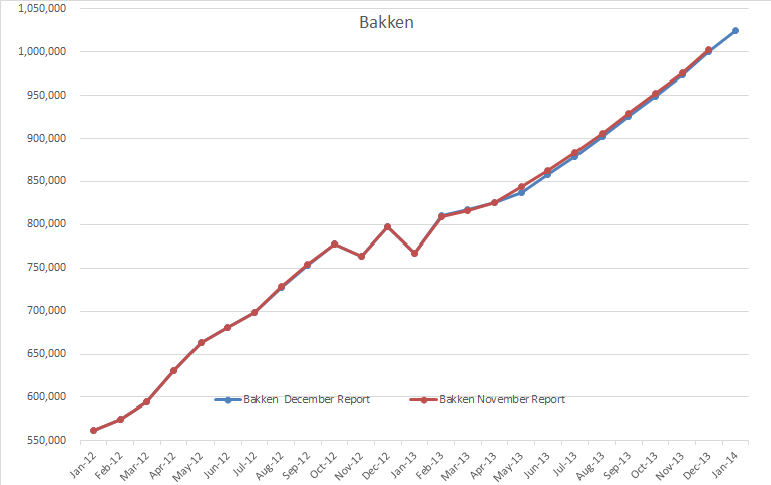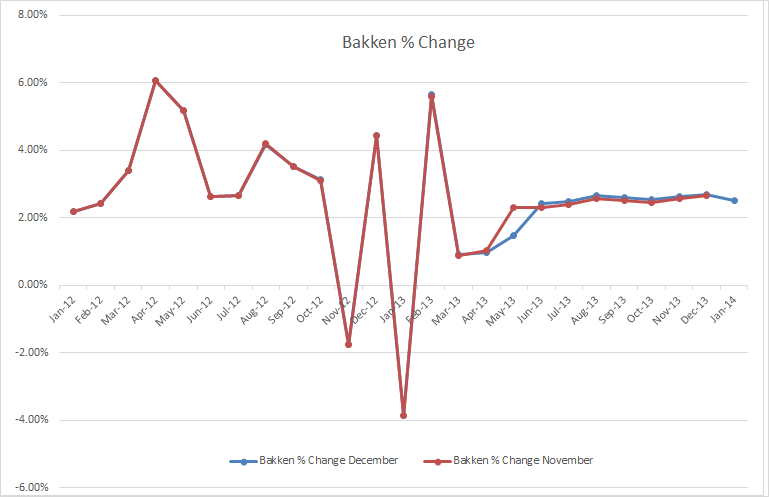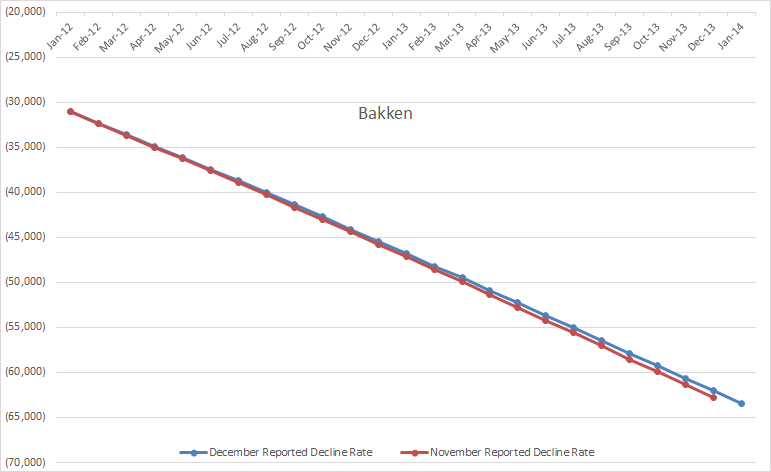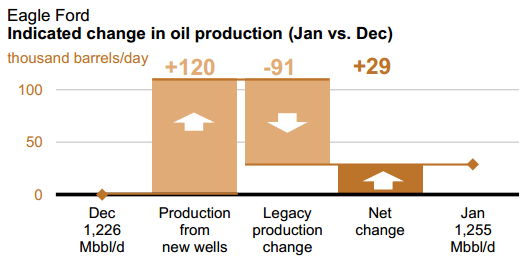The new EIA Drilling Productivity Report has just been published with their shale oil production and prediction numbers out through January 2014.
I have discovered something very strange about their numbers. But first here is the Bakken data. I have shortened the time frame to just two years in order to better show what is happening. I have plotted what the EIA reported last month along with what they reported in this last report. The data is in barrels per day.
There was extremely little revision in the data from the report last month.
And now Eagle Ford Production in barrels per day.
Eagle Ford was revised downward and like the data, the revisions were extremely linear. But the dead give away was when I plotted the percent change of from month to month.
The last eight months show almost the exact rate of change, about 2.5 percent increase month after month. They are just plugging in numbers!
Eagle Ford shows the same pattern except like the data, they have revised the rate of change downward somewhat.
The decline rates are extremely linear also. The Bakken decline rate in barrels per day.
There was very little revision here but what there was they figured it was not declining quite as fast as they thought it was. And the Eagle Ford Decline Rate in barrels per day.
There was a slightly greater revision here and they figured that it was declining a bit faster than they first thought it was. They figure that Eagle Ford, will be in January, declining at 91,000 barrels per day but they will be producing new oil at the rate of 120,000 barrels per day meaning production will be increasing, in January, at the rate of 29,000 barrels per day.
What is happening here, I think, is that they are taking the data from North Dakota and the Texas RR Commission up until about June then they just plug in their own very linear numbers.






Impressive finding. Which means that official production data is in fact a raw estimate for at least 6 months…and that large revisions will be done when actual data arrives. Btw, they signal nowhere that it is an estimate, which is not correct.
Thank you for your work, your graphs allow to follow world crude production where everyone else seems to have lost interrest.
Not everyone has lost interest. I quickly saw the decline rates and connected the need to drill ever increasing numbers of wells jus to maintain production and knew this was short term deal. The interest for me is the denial. I spent yrs as a therapist and denial was a common issue but I saw it in particular situations. I now see it as the human condition. It is the norm. Facing reality is abnormal and is the very last thing we will do. There is nothing to be done to stop it.
And my guess is that we will see some pretty large downward revisions to November and especially December when the actual numbers come out in the months ahead. Seems like these winter storms really put a hurting on ND and TX oil production.
As mentioned before, there would be two effects of weather. 1) the fracking trucks can’t get to the wells, so those wells are delayed in drilling. Loss from this effect is no more than the decline rate. 2) The **oil** trucks can’t move, they can’t carry oil from the wells already drilled. The loss from this effect would be huge. 100s of K bpd. BUT . . . only effect number 1 lasts meaningfully. The 100 day clock on completions gets interrupted so new oil doesn’t start — to offset the decline — until completions are complete. Effect number 2 reverses immediately. 200K down is restored as soon as the trucks roll.
Here is an interesting tid bit that appeared in the the Business Journal serving Milwaukee.
Schneider National shuts down San Antonio sand-hauling operation
“Trucking heavyweight Schneider National Inc. has pulled out of San Antonio, dropping its business of hauling sand for Eagle Ford Shale oilfield service companies.
Green Bay-based Schneider has closed its San Antonio yard and notified the Texas Workforce Commission it cut 76 positions there, mostly drivers.
“Like all companies, Schneider National’s business is heavily influenced by demand in the marketplace,” Schneider spokeswoman Janet Bonkowski said in an emailed statement. “Earlier this year, we decided that the opportunities in the (sand) portion of our energy transportation business are not as strong as anticipated and ceased offering transportation services to this market.”
http://www.bizjournals.com/milwaukee/news/2013/12/12/schneider-national-shuts-down-san.html?ana=RSS&s=article_search&utm_source=feedburner&utm_medium=feed&utm_campaign=Feed%3A+bizj_milwaukee+%28Milwaukee+Business+Journal%29
So we should expect Eagle Ford Shale Oil production to decline even faster.
I also think so that The oil trucks can’t move, they can’t carry oil from the wells already drilled. The loss from this effect would be huge. 100s of K bpd. BUT . . . only effect number 1 lasts meaningfully.
great post thanks for share!!
100$ PER BARREL OIL; GREAT START FOR TEXAS OIL DRILLING